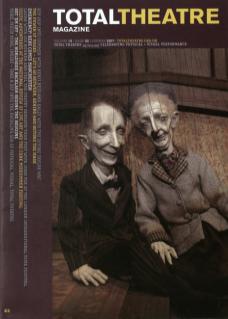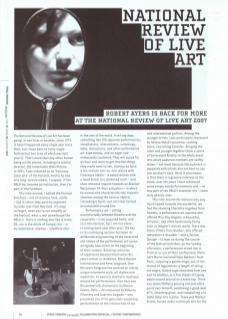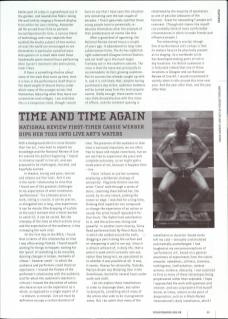The National Review of Live Art has been going, in one form or another, since 1979. It hasn't happened every single year since then, but I have been to every single festival but two (one of which was last year's). That's more than any other human being on the planet, including its artistic director, the remarkable Nikki Milican. In 2001, I was inducted as an 'honorary associate' of the festival, mostly by way of a long-service medal, I suspect. If the NRLA has become an institution, then I'm part of the furniture.
This time around, I edited the festival brochure – not an onerous task, really – but in return they paid my expenses to come over from New York. It's easy to forget, when you're not actually at the festival, what a real powerhouse the NRLA is. There is nothing else like it in the UK, nor in the whole of Europe, nor – in my experience, anyway – anywhere else in the rest of the world. Five long days, something like 100 separate performances, installations, interventions, screenings, talks, discussions, and other performance art-type events, and an eager and enthusiastic audience. They will queue for an hour and more to get into the things they really want to see, clamour to have a ten-minute one-on-one séance with Francesca Steele – a naked women with a hand mirror in a darkened room – and show immense respect towards an Alastair MacLennan 24-hour actuation in which he moved with characteristically majestic slowness among the various objects (including a burnt-out car) that he had accumulated around him.
Performance art – sitting uncomfortably between theatre and the visual arts – is an acquired taste, and so is this festival, but I am not alone in coming back year after year. The key to its continuing success has been its deliberate programming of the venerated old-timers of the performance art canon alongside newcomers at the beginning of their careers. Boasting centuries of experience between them were this year's artists in residence, Black Market International and Anne Seagrave. Over the years Seagrave has evolved an utterly unique movement style, all rhythm and repetition, to weave a mesmeric mystique around her performances. Also here was the perennially charismatic Guillermo Gómez-Peña – accompanied by Roberto Sifuentes and Gabriela Salgado – who presented one of his genuinely unsettling performances at the intersection of sex and international politics. Among the younger artists I was particularly impressed by Helena Walsh's placenta-cooking piece, Consuming Colonies. Bringing the older and younger together lends a sense of benevolent kinship to the whole event into which audience members are swiftly drawn – not least because the audience is peppered with artists who are keen to see one another's work. What it also means is that there is a genuine riskiness to the event: over the years I have witnessed some simply wonderful moments and – no less part of the NRLA's essential mix – some truly ghastly ones.
This time around the balance was very much tipped towards the wonderful: we had the stunning Charlotte Engelkes from Sweden, a performance art soprano who offered Miss Very Wagner, a beautiful, virtuosic, and often hysterically funny take on Wagner's artistic world. There was Alexis O'Hara from Québec, who offered spectators a shoulder – and a Sorrow Sponge – to lean on during the course of the festival and then, on the Sunday afternoon, a performance mixed live in front of us out of their confessions. There were Marie Cool and Fabio Balducci from Paris, conjuring a gentle magic out of the merest of ingredients: a length of string set alight, Scotch tape stretched from one wall to another, or a few sheets of typing paper moved around on a table top. There was Jamie McMurry pouring red and white paint over himself, swallowing a good deal of it, smashing glass, and catapulting a lit table lamp into a pillar. There was Marilyn Arsem, buried under cold black dirt for the better part of a day in a greenhouse out in the garden, and Gwendoline Robin risking life and limb by staging a firework display from within her own clothing. Alexander del Re arrived from Chile to perform Social Education for Girls, a curious blend of technology and crazy slapstick that tackled the knotty subject of how women all over the world are encouraged to see themselves in particular curtailed ways. And upstairs in a small dark room Daan Vandewalle spent several hours performing Alvin Curran's mesmeric solo piano piece, Inner Cities.
If there is something irksome about some of the work that turns up here, then it is less in the performance itself than in the dead weight of absurd theory under which many of the younger artists find themselves labouring when they leave our universities and colleges. I am told that this is a temporary trend, though I would have to say that I have seen this situation only worsening over the last couple of decades. I find it genuinely sad that these young people have to perennially reeducate themselves after the example of their predecessors at events like this.
After a good deal of agonising, the National Review moved house a couple of years ago. It abandoned its long-time subterranean home, The Arches nightclub right underneath Glasgow Central Station, and set itself up in the much larger Tramway out in the southern Suburbs. The irony is that the move was principally to accommodate its fast-growing audience. But its success has already caught up with it, and it is still likely that, despite having purchased a day ticket, audience members will be turned away from the most popular events. Oddly enough, there seems to be very little dissatisfaction with this state of affairs, and the constant queuing is celebrated by the majority of spectators as one of peculiar pleasures of the festival. 'Great for networking!' people will comment. (Though old-timers like myself can probably think of more comfortable circumstances in which to make friends and influence people.)
The networking is crucial, though. One of performance art's virtues is that its makers have to be physically present at its staging. So a worldwide circle has developed making ports of call in key locations. For British audiences it is fortunate indeed that one of those locations is Glasgow and our National Review of Live Art. I would recommend it warmly when it rolls around this time next year. And the year after that, and the year after that.


